Invertebrates make up 97% of animal species. All animals are worthy of love. More from me at excentricat1.tumblr.com
Don't wanna be here? Send us removal request.
Text
8K notes
·
View notes
Text
Moneilema , os besouros de chifres longos de cactos são um gênero de besouros pretos grandes e incapazes de voar encontrados nos desertos norte-americanos do oeste dos Estados Unidos e norte do México. Como não voam, andam como podem.
4K notes
·
View notes
Text
People who like mantises but aren't that into entomology are always "orchid mantises" this and "orchid mantises" that. Overrated. Can we talk about Toxodera integrifolia for a minute:



(Image links because as much as it pains me I've never seen one of these beauties irl: 1 2 3)
Like how are these things real. Girl what is that thorax shape. Why are you wearing eyeliner. And the colors? Absolutely fire. This is a 10/10 insect if you ask me.
33K notes
·
View notes
Text
Fun fact: there’s a virus that makes bugs iridescent





disease that makes you beautiful then kills you
21K notes
·
View notes
Text
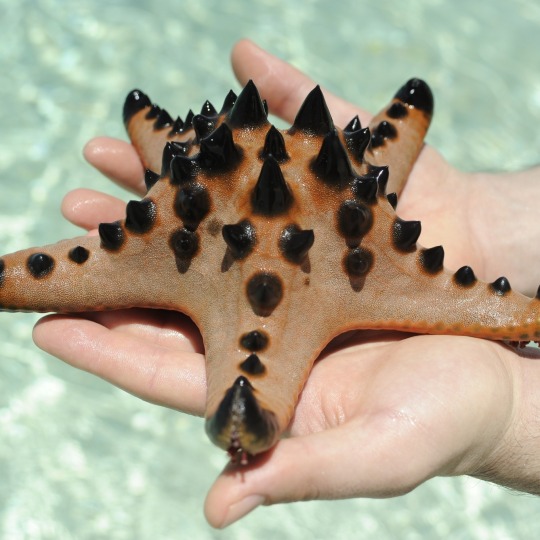
🍪 Feeling hungry? Well, despite its name, the chocolate chip sea star (Protoreaster nodosus) probably wouldn’t taste very good. To start, those “chips” aren't chocolate at all… they’re tubercles, or knobs, and they’re unique to each sea star. No two individuals have the same arrangement of tubercles!
Like many other sea stars, this marine invertebrate eats by pushing its stomach out of its mouth, covering its meal, and then digesting it externally. This critter inhabits the warm waters of the Indian Ocean and Pacific Ocean, where it might be spotted around coral reefs or seagrass beds. It can grow up to 12 inches (30 cm) across.
Photo: woodgreg, CC BY-NC 4.0, iNaturalist
879 notes
·
View notes
Text
Giant Emerald Pill-Millipede: when these enormous millipedes are all rolled up, their bodies can be as big as a baseball, a tennis ball, or a small orange

This species (Zoosphaerium neptunus) is commonly known as a giant emerald pill-millipede. The females can measure up to 90mm long (roughly 3.5 inches), making this the largest species of pill-millipede in the world.

There is a significant degree of sexual dimorphism in this species, with the males measuring only about 45mm (1.8 inches) long -- roughly half the size of the females.
Giant emerald pill-millipedes are found only in Madagascar, which is home to several endemic species of giant pill-millipedes (order Sphaerotheriida). The Malagasy name for giant pill-millipedes is "Tainkintana," which means "shooting-star."

Pill-millipedes use conglobation as a defense mechanism, which means that they can curl their bodies up into a spherical shape so that their dorsal plates form a protective shield around the softer, more vulnerable parts of their bodies, just like an actual pill-bug or a "roly-poly."
When they roll themselves up completely, they look almost like gently polished chunks of malachite, emerald, or jade.
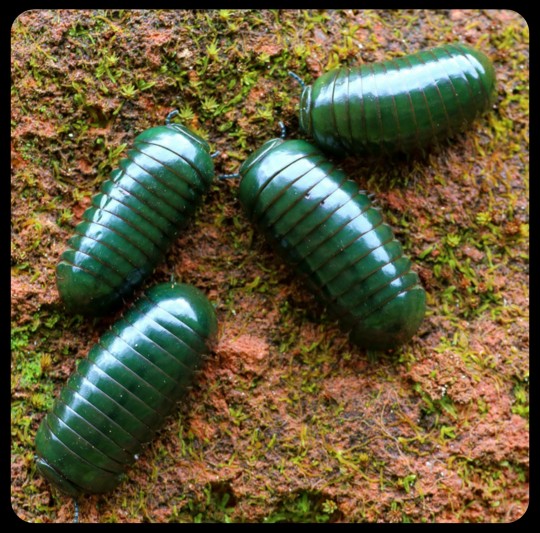
Giant emerald pill-millipedes will sometimes form large swarms that travel together as a group. This is the only species of giant pill-millipede that engages in any sort of swarming behavior, and the purpose of that behavior is still unclear. The swarms often contain thousands of individuals, with almost all of them moving in the same direction, even when there is no physical contact that might allow the millipedes to "herd" one another along.
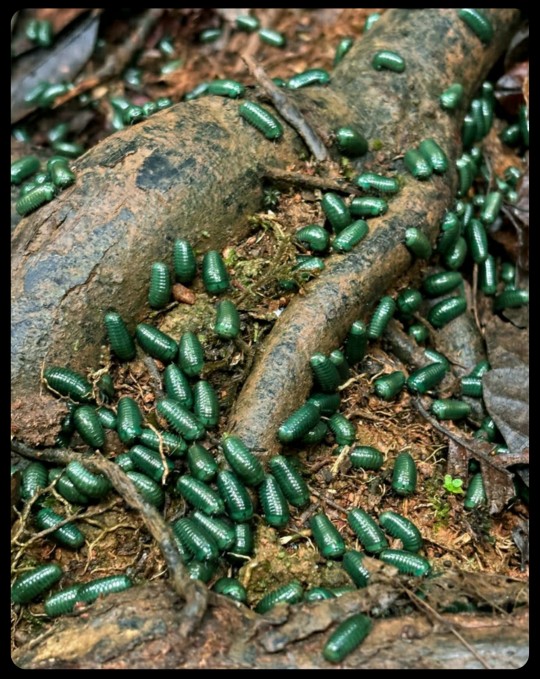
Their swarming behavior also has some very peculiar features, as this article explains:
During swarming, Zoosphaerium neptunus individuals pay little attention to their surroundings; many specimens were observed walking straight into and drowning in small puddles. Some swarms even display ‘cliché lemming behaviour:' in Marojejy, a large part of a swarm walked into and drowned in a small river.
No single specimen was observed walking ‘against the current,' all specimens were moving in the same direction (southeast), even when not in contact with one another.
Of 273 randomly collected individuals, 105 were males, while 168 were females. The males were 8.3 - 14.1 mm wide (average width 10.4 mm). According to the inner horns of the posterior telopods, all males were sexually mature. The females were 9.95 - 15.4 mm wide (average width 11.4 mm). All females displayed non sclerotized vulvae and were sexually immature.
Some researchers argue that the swarming serves as a defense mechanism, providing a layer of protection (or at least some cryptic cover) against local predators, but the swarming behavior is still poorly understood.

Important Note: I just want to remind everyone that these animals belong in their own natural habitat -- they should not be trapped, bought/sold, traded, shipped, collected, or kept as pets. This particular species does not survive well in captivity, either, and the demand for these "exotic" invertebrates is putting the wild populations in jeopardy. The previous article discusses those issues, too:
Another possible threat for Z. neptunus swarms are collections for the pet trade. There exists a large demand in Japan, Europe and North America for 'green -eyed monsters’ as pets. Giant pill -millipedes from Madagascar unfortunately have a very short survival time in terraria. The species is specialized on low-energy food (dead leaves), and adapted to the cool climates (<20°C) of the highlands. Specimens in terraria often starve to death quickly.
So I know that they're adorable and really, really fascinating...but let's just let them be their chunky, adorable little selves out in the wild where they belong.
Sources & More Info:
European Journal of Taxonomy: Seven New Giant Pill-Millipede Species and New Records of the Genus Zoosphaerium from Madagascar
Madagascar Conservation & Development: Swarming Behavior in the World's Largest Giant Pill-Millipede, Z. neptunus, and its Implication for Conservation Efforts
Bonn Zoological Bulletin Supplementum: The Giant Millipedes, Order Sphaerotheriida (an Annotated Species Catalogue) (PDF)
African Invertebrates: Madagascar's Living Giants: Discovery of Five New Species of Endemic Giant Pill-Millipedes from Madagascar (PDF)
8K notes
·
View notes
Text

Oh wow who woulda thunk
#This was the final straw in why I never gonto Walmart#Everything is locked up but there’s still only like 3 employees in the whole store#I just wanted a pack of socks
23K notes
·
View notes
Text

I have been gifted a new work friend.
1 note
·
View note
Photo

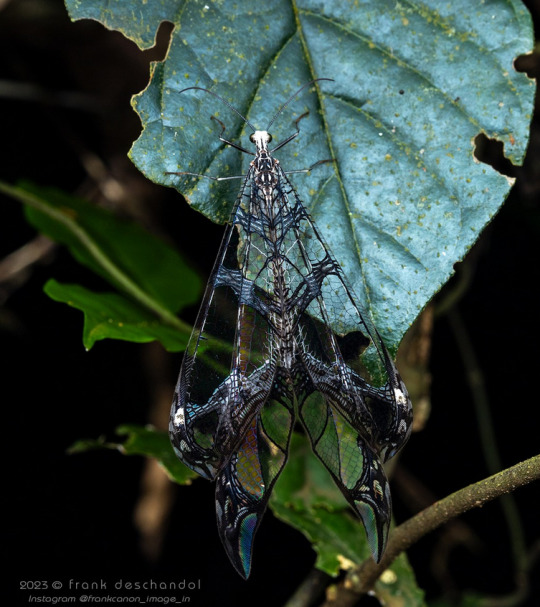
Treehole antlion, Cymothales sp., Myrmeleontidae
Photographed in Mabira Forest, Uganda by Frank Deschandol
Shared with permission; do not remove credit or re-post!
7K notes
·
View notes
Text
by the way it is very important to me for you to know that Sphagnum mosses come in pink.
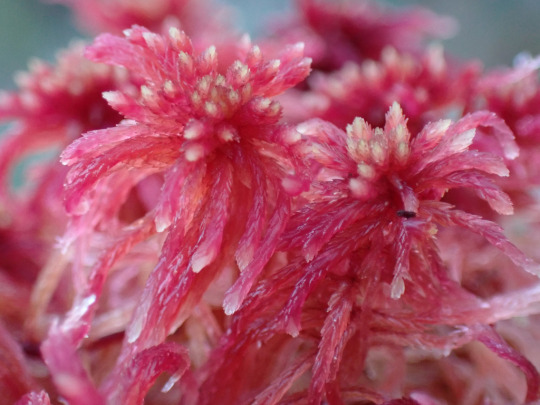
Sphagnum subnitens
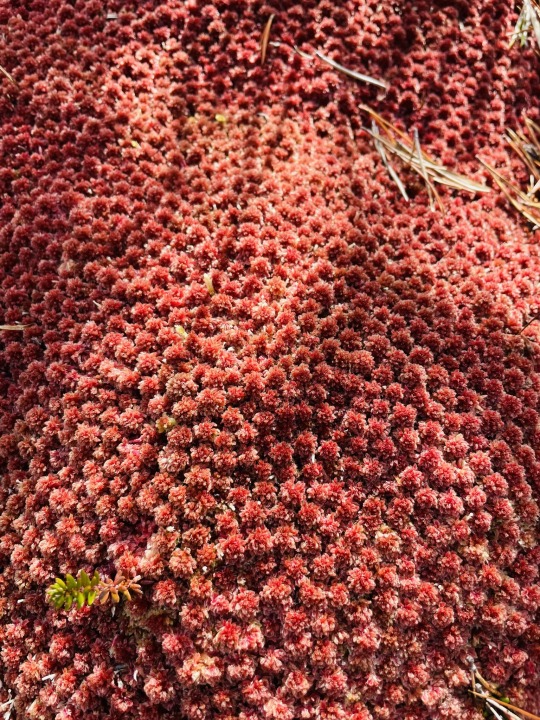
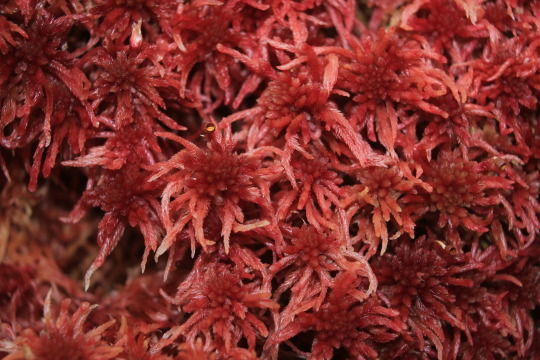
Sphagnum rubellum
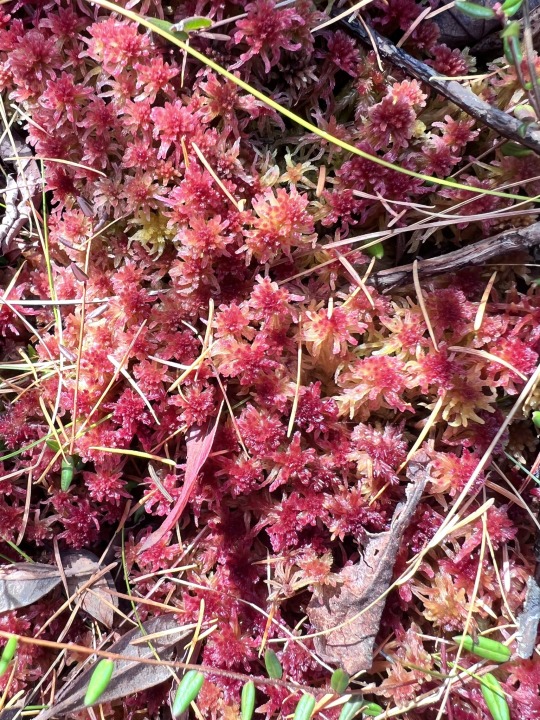
Sphagnum magellanicum
2K notes
·
View notes
Text
Round 2.5 - Tardigrada - Heterotardigrada




(Sources - 1, 2, 3, 4)
The other tardigrade class, Heterotardigrada (“Rough-bodied Tardigrades”) consists of the orders Arthrotardigrada and Echiniscoidea.
Heterotardigrada includes most of the marine species of tardigrade, though one lineage is adapted to a terrestrial environment. In contrast to eutardigrades, they do not look as “squishy”, instead having cuticular armour at least on their dorsal side. They have four seperate claws on each foot, aligned side by side in one row. Like eutardigrades, they can also survive in a dormant state if their habitat dries out, however they’re less likely to need this adaptation as most heterotardigrades are aquatic!
Unlike eutardigrades, heterotardigrades do not seem to have a fossil history.

(source)
25 notes
·
View notes
Text
Round 2.5 - Tardigrada - Eutardigrada
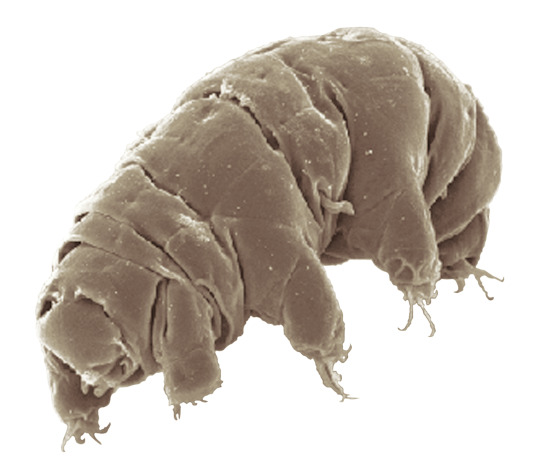


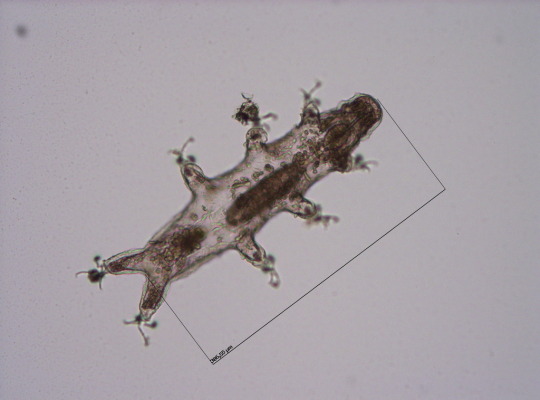
(Sources - 1, 2, 3, 4)
One of two classes of tardigrades, Eutardigrada (“Smooth-bodied Tardigrades”) consists of the orders Apochela and Parachela.
When you picture a tardigrade, it is probably a eutardigrade. Eutardigrada contains the most species of the two tardigrade classes. Most of them are terrestrial, though some are adapted to a freshwater or marine habitat. As opposed to heterotardigrades, eutardigrades are smooth and sausage-shaped, and lack external sensory organs. Their claws are combined into double claws or aligned in two rows.
Most of the scientific study on the survivability of tardigrades has been done on eutardigrades. They are known for their extreme resilience, being able to survive extreme temperatures and pressures, air deprivation, radiation, dehydration, starvation, and even exposure to outer space. However, they prefer to just live in mosses, lichens, and sediments, munching away on plant cells, algae, bacteria, or small invertebrates (including smaller tardigrade species; that’s not cannibalism btw, plenty of chordates eat other chordate species!) They are not considered extremophiles though, as they are not adapted to exploit extreme environments, only to endure them. They do this by going dormant in harsh environments, for up to 30 years, only to rehydrate and continue living when conditions are safer!
Members of Eutardigrada have been around since at least the Middle Cretaceous. The oldest known living species are Beorn leggi and Aerobius dactylus, which have existed since the Late Cretaceous!
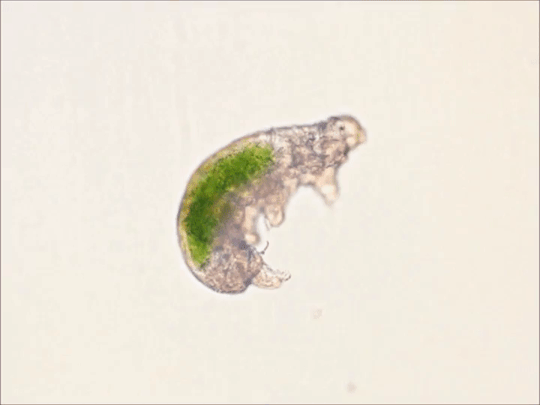
76 notes
·
View notes
Text
Round 2.5 - Platyhelminthes - “Turbellaria”


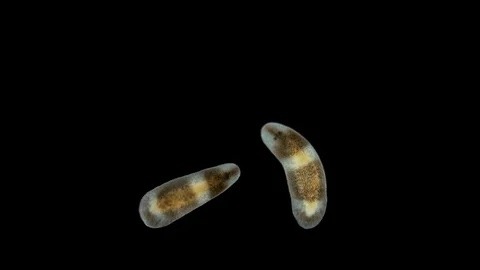

(Sources - 1, 2, 3, 4)
Unfortunately, “Turbellaria” is a paraphyletic class and is no longer valid. Many of the orders within this group are more closely related to their parasitic cousins than to each other. While I am doing my best to avoid paraphyly in this tournament, there are many groups formerly within Turbellaria that have not been assigned a higher classification yet, and I do not want to leave them out. So for now, this is an oddball poll that includes the unrelated orders Bothrioplanida, Gnosonesimida, Polycladida, Prolecithophora, Prorhynchida, Proseriata, Rhabdocoela, Tricladida, Macrostomida, Dolichomicrostomida, the family Haplopharyngidae, and the genera Bradynectes and Myozona.
That being said, this is a group that encompasses the “free-living flatworms” that do not live parasitic lifestyles.
Like all platyhelminths, turbellarians have no internal body cavity and lack specialized circulatory and respiratory organs, so gas exchange is by simple diffusion. They are either microscopic or are flat and ribbon- or leaf-shaped, and vulnerable to fluid loss, so are relegated to aquatic or moist environments. Their body is filled with mesenchyme, a connective tissue that can regenerate injured tissues and permits asexual reproduction. The nervous system is concentrated at the head end. Most turbellarians are predators or scavengers, and terrestrial species are mostly nocturnal and live in shaded humid locations such as leaf litter or rotting wood. Carnivorous turbellarians usually have an eversible pharynx that can be extended by being turned inside-out, and the mouths of different species can be anywhere along the underside. However some are symbiotes of other animals such as crustaceans, and some are parasites. Small aquatic species use cilia for locomotion, while larger ones use muscular movements of the whole body or of a specialized sole to creep or swim. Some are capable of burrowing, anchoring their rear ends at the bottom of the burrow, then stretching the head up to feed and then pulling it back down for safety. Some terrestrial species throw a thread of mucus which they use as a rope to climb from one leaf to another.
All turbellarians are simultaneous hermaphrodites, having both female and male reproductive cells, and fertilize eggs internally by copulation. Some of the larger aquatic species mate by “penis fencing”, a duel in which each tries to impregnate the other, and the loser adopts the female role of developing the eggs. Unusually among animals, in most species, the sperm cells have two tails, rather than one. In most species miniature adults emerge when the eggs hatch, but a few large species produce plankton-like larvae. Many turbellarians can also clone themselves by transverse or longitudinal division, and others may reproduce by budding.
Turbellarians, or at least free-living Platyhelminths, emerged in the Middle Triassic.

Propaganda under the cut:
Planarian flatworms can regenerate new heads, tails, or entire bodies thanks to their vast amounts of pluripotent stem cells, cells that can essentially become any cell in the body.
Two planarian species were successfully introduced to the Philippines, Indonesia, Hawaii, New Guinea, and Guam to control populations of the invasive Giant African Snail (Achatina fulica), which was displacing native snails. (However, they ended up also being a threat to the native snails, who woulda thunk)
Some planarians are being used for mosquito control. These species can live in artificial containers that attract mosquitoes, so they are less likely to become invasive themselves.
Land planarians tend to get a bad rap due to several invasive species, but there are over 830 other species of land planarian who are just doing their thing
The freshwater species Microstomum caudatum can open its mouth almost as wide as its body is long, to swallow prey as large as itself.
Marine flatworms can detect approaching threats via light and dark sensitive cells on their pseudotentacles (the little folds on their heads that look like eyestalks.) They basically mimic having eyes and it works
Many marine flatworms mimic poisonous nudibranchs (which are molluscs) and some terrestrial flatworms mimic venomous snakes (which are chordates), both animals which are very very far removed from flatworms
Many tropical flatworms can be just so, so beautiful:

Flat Freak Fursday
47 notes
·
View notes
Photo



Phasmid eggs | Levon Biss
these are actual eggs of the stick insect family
9K notes
·
View notes


